As a reader of our website (or a viewer of our YouTube channel), you’ve probably got at least a passing familiarity with different kinds of fabrics and what goes into them. Today, we’re covering another fabric term with a bit of mystique surrounding it: “madder silk,” also sometimes referred to as “ancient madder.”
History Of Madder Silk
The “madder” in madder silk simply refers to a plant: Rubia tinctorum (also called Rubia tinctoria, common madder, or dyer’s madder), from which natural dyes can be extracted. Use of the plant dates all the way back to 1500 BCE, and it’s also been used in various locations such as Africa, Greece, Italy, and Central Asia. In other words, it’s been used since ancient times–hence the term “ancient madder”–as a dye for leather and fabrics, including cotton, wool, and silk. A piece of cotton dyed with madder has been recovered from the archaeological site at Mohenjo-daro (now in Pakistan), and historical figures such as Pliny the Elder and Charlemagne wrote about madder.
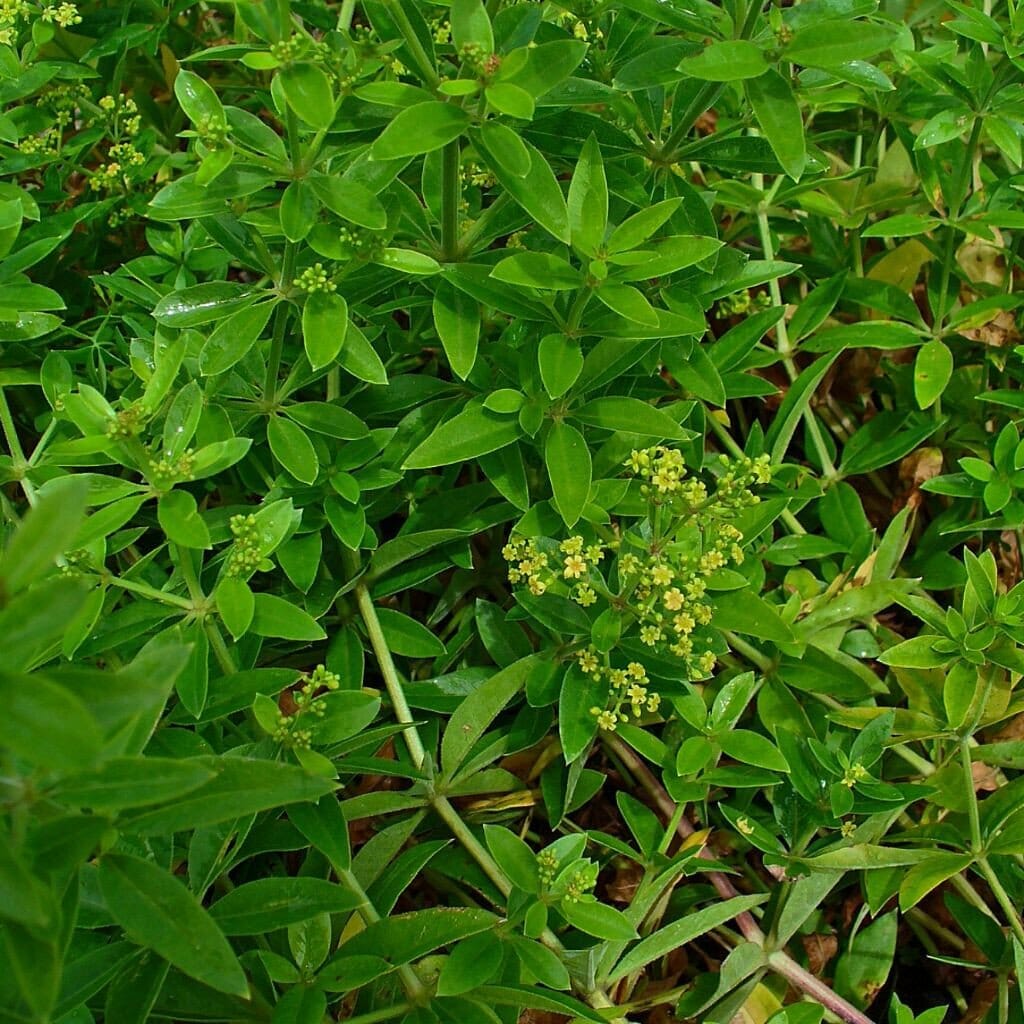
Focusing for a moment on how the dye itself is actually produced, it starts with harvesting the plant after about two years of growth, followed by drying and fermenting the roots of the plant. Red dyes called alizarin and purpurin are thereby extracted. These dyes were first isolated by the French chemist, Pierre Jean Robiquet, in 1826. Alternatively, the roots can also be dissolved in sulfuric acid, which leaves a dye called garance (the French word for madder). In 1869, German chemists were able to synthesize artificial alizarin dye, effectively ending the need for cultivation of natural madder roots. Relating our historical overview specifically to the topic of menswear: madder silk ties, primarily produced in England, became a staple of Ivy style on college campuses beginning in the 1930s.
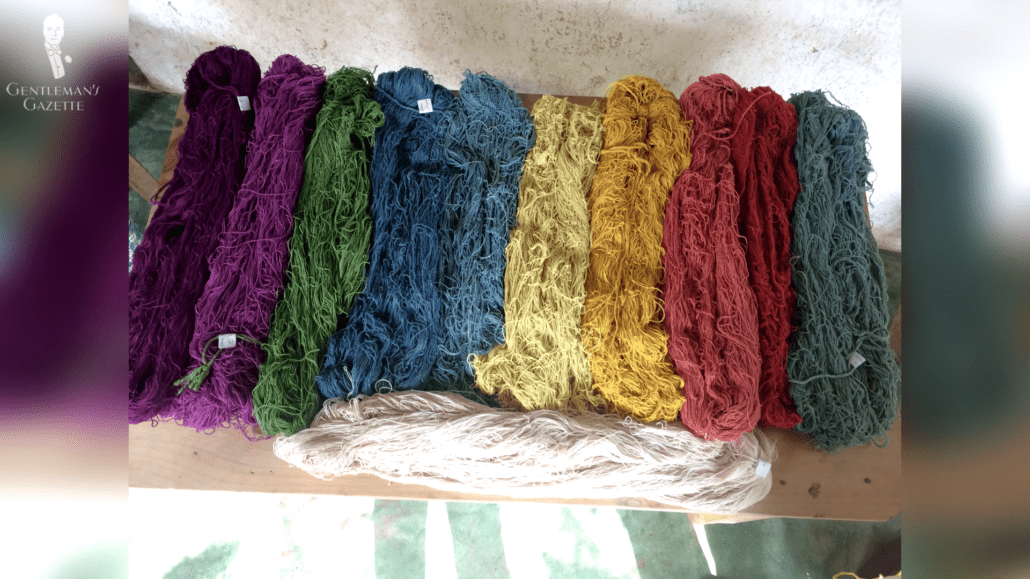
As an alternative to the repp stripe patterns that were standard at the time, madder ties were often seen either in paisley or in small, repeating, geometric patterns. According to author and menswear historian, G. Bruce Boyer, they were considered “the king of campus ties, inevitably more expensive than the other ties, but more prestigious and discriminating.”
What Makes Madder Silk Special?
While natural madder root produced primarily only red dyes, the modern dyeing process for madder can produce a wide array of rich, saturated hues. Most of these colors are on the darker end of the spectrum; think, for example, of colors like mustard, forest green, burnt orange, deep blue and violet, and of course, red and burgundy. Madder ties are now always printed on a twill silk fabric that has been treated with gum arabic, leading to a distinctive finish and feel; this is referred to by the experts and those in the industry as a chalk hand.
Specifically, the silk used is first boiled to remove its natural gum, which is an organic resin. The silk is dyed whatever color(s) it’s going to be, and then artificial gum is added back in, to give the tie that distinctive, chalky feel. Regarding pattern choices: as we mentioned previously, madder ties are almost always produced in either paisley or repeating geometric designs. This combination of the rich-but-subtle colors and the neat-but-intricate designs will give a madder tie an unmistakable touch of refined class. Madder ties will then be visually interesting and somewhat playful, but also suitably formal for a wide variety of situations.

Where To Buy Genuine Madder Silk
While fewer manufacturers today produce madder ties than was true in the previous century, there are still a few retailers who carry them. These manufacturers would perhaps most famously include Drake’s of London but there are also others, such as J. Press and Sam Hober. With that said, though: you don’t have to go any further to find a genuine madder tie than right here at Fort Belvedere!
What Makes Our Fort Belvedere Madder Silk ties So Special?
Firstly, production of madder silk is a difficult, multi-step process of screen printing, and only the highest quality silks can be used. As a matter of principle then, Fort Belvedere sources all of its ancient madder directly from England. To produce a blue madder tie, for example, a natural white base cloth will be outlined with a pattern, and highlight colors will be applied to certain areas.
Once the pattern printing is finished, the fabric is immersed in an indigo bath, rendering the omitted areas madder blue. And in addition to their rich colors, Fort Belvedere madder silk ties also feature the distinctive chalk hand of genuine madder neckwear. Our ties are untipped and sport fine hand-rolled edges, a carefully chosen interlining chosen for ideal knots, and a signature green 3-ply silk yarn from Germany for additional durability. Finally here, Fort Belvedere offers three different lengths of ties, so that any man can properly size the tie that he wants for his specific height.
Setting aside genuine madder ties for a moment, it is true that you can find imitations out there–but of course, it should go without saying that a true gentleman will demand the genuine product.
Best Ways To Wear a Madder Silk Tie
In the most general terms, madder ties are particularly well-suited for fall, although they can be worn year-round depending on how you choose to incorporate the color palette into your outfit. As an example, you could combine a tweed jacket or full suit with an Oxford cloth button-down shirt and a madder silk tie for a distinctly Ivy-inspired look. In addition to tweed, most heavier fabrics with some heft and texture to them will pair well with madder silk ties. Overall, given that madder silk has an historical pedigree just as rich as the colors it produces, madder ties (and pocket squares) should be a staple of any discerning gentleman’s wardrobe.
Outfit Rundown
My outfit today features both a madder silk tie and a madder silk pocket square, both from Fort Belvedere. The tie is in orange-red and it features a repeating geometric pattern in buff. Meanwhile, the pocket square is in dark bronze, and it features a red and green diamond pattern with a paisley border. Between the paisley pocket square and the geometric pattern tie, both of the main patterns for madder silk are represented in today’s outfit.
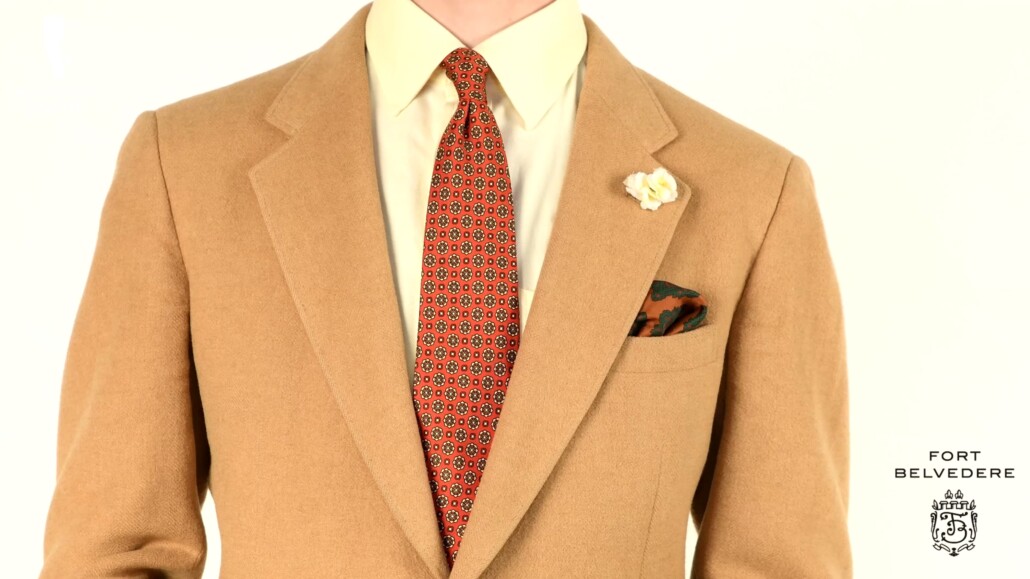
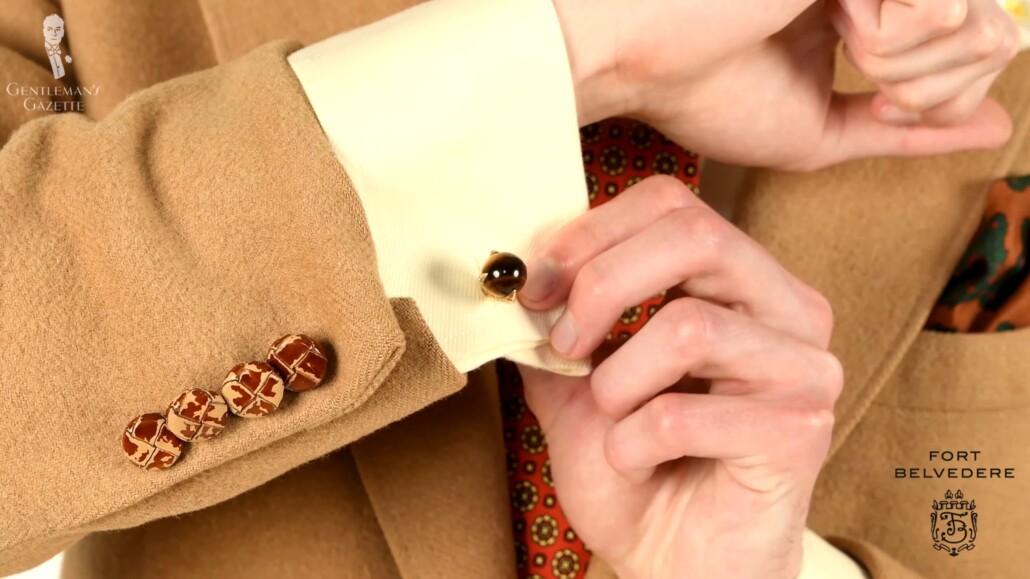
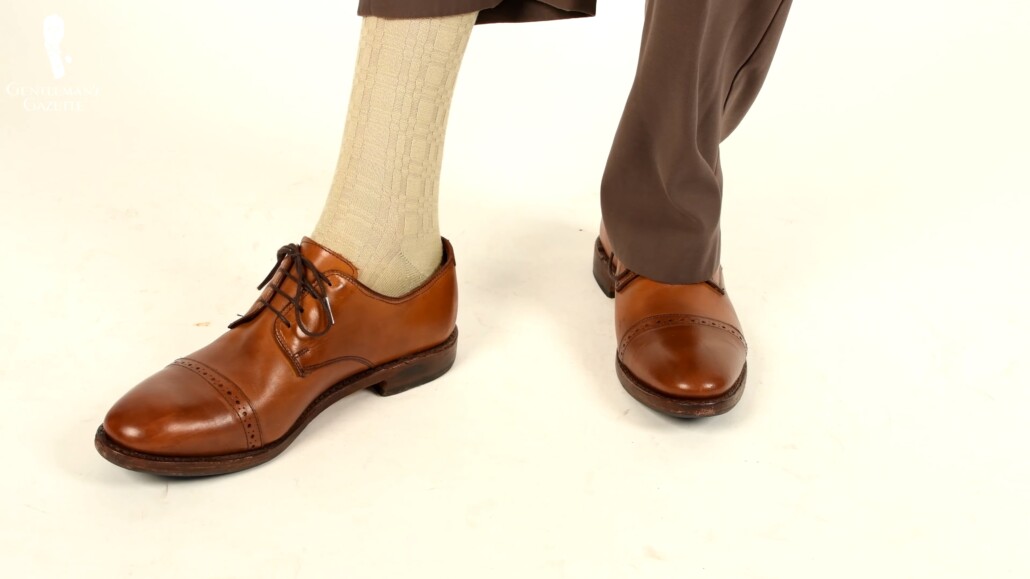
To harmonize well with this warm color palette, then, I’m wearing a camel hair sport coat and a yellow French cuff shirt from Charles Tyrwhitt. My trousers are in plain brown in a shade that’s a little bit darker than the camel hair color, and my socks are in buff to harmonize with the shirt and the pattern on the tie. They also feature a pattern, which is a geometric pattern of repeating squares. My tan cap-toe derby shoes go well with the jacket, and they feature a little bit of broguing along the cap toe. They’re from Allen Edmonds. Also from Fort Belvedere today are my cufflinks, which are gold-plated sterling silver links in an eagle claw design, and featuring tiger’s eye as the stone, as well as my boutonniere, whose flower is white phlox. You can find the madder silk tie and pocket square, as well as the boutonniere and cufflinks, and a wide variety of other men’s wear accessories in the Fort Belvedere shop.
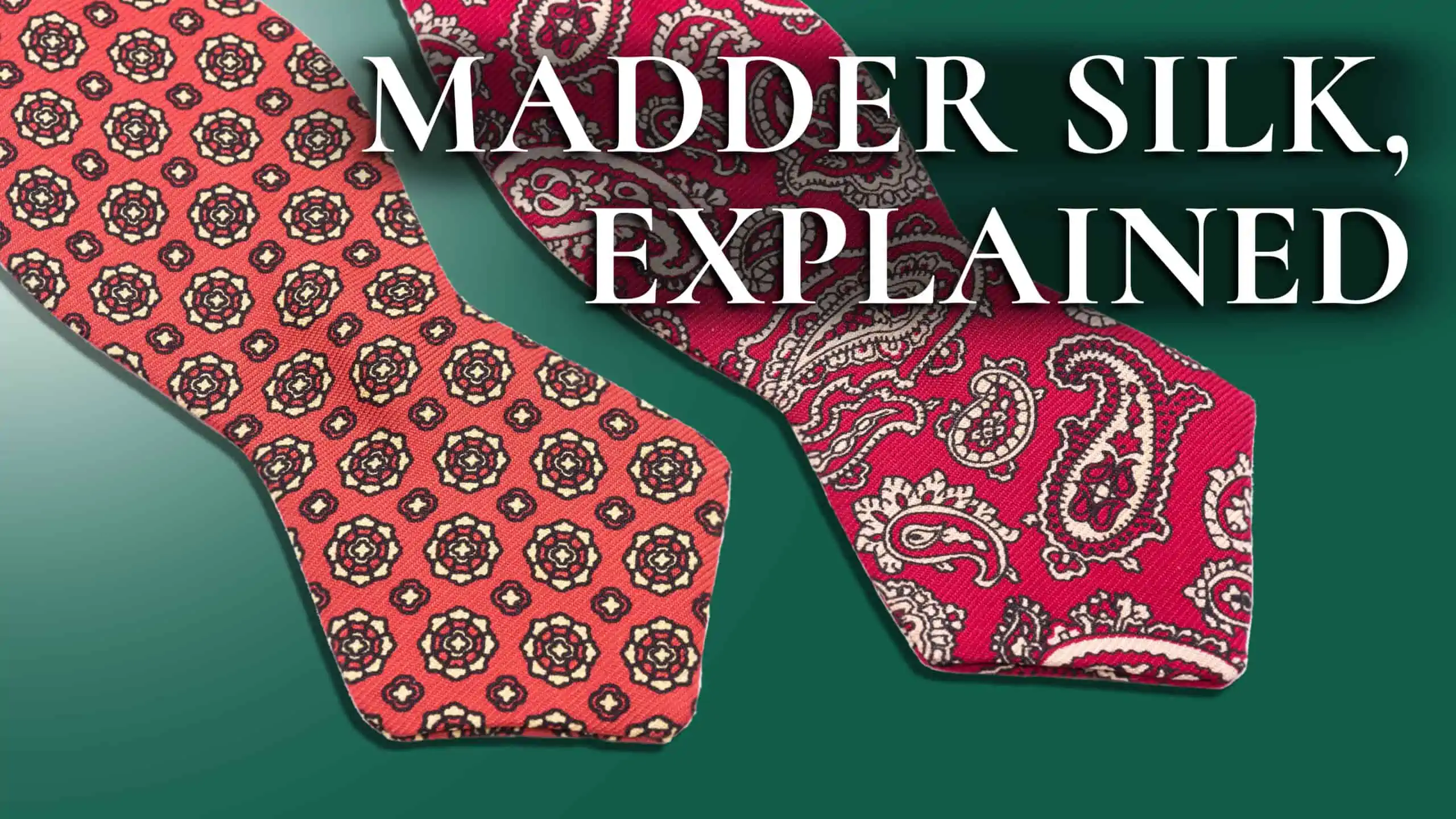
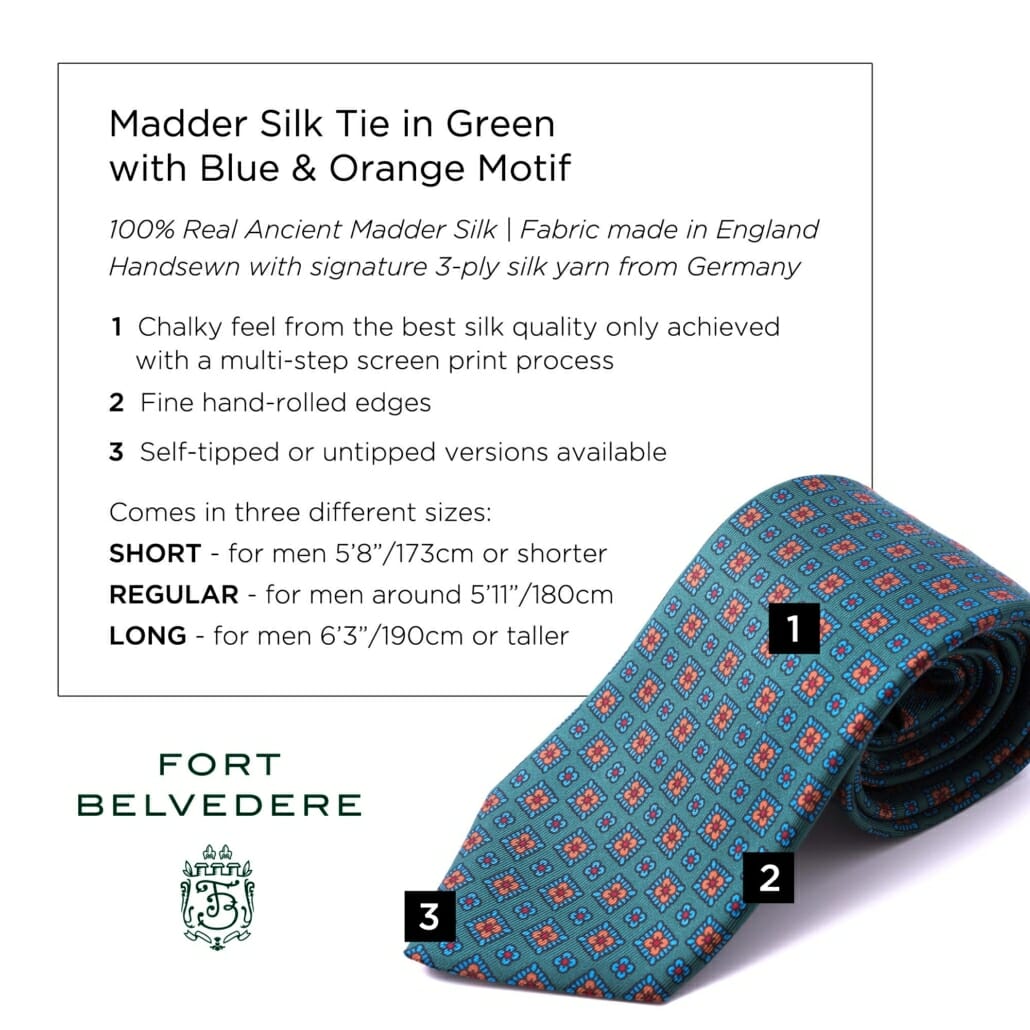
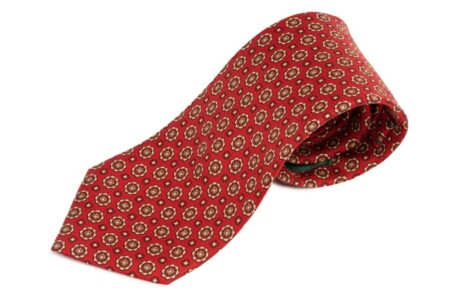
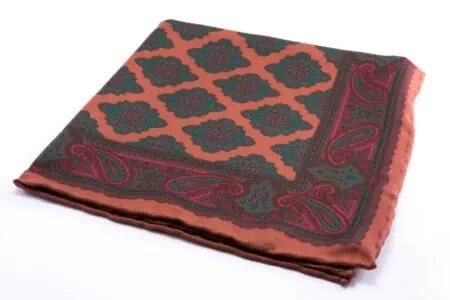
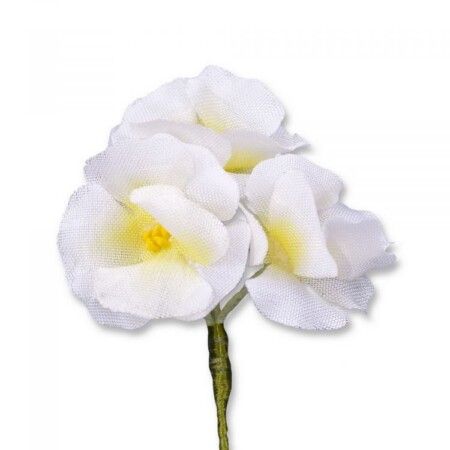
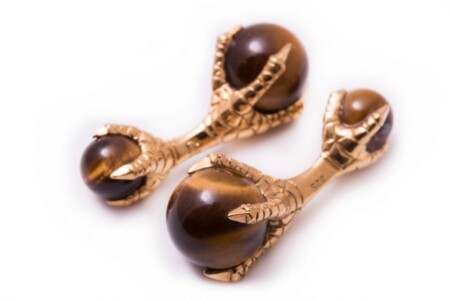
I can’t thank you enough for this discussion of the natural dye madder. My career in surgical pathology has stimulated my long held interest in the use of dyes to stain human tissues and no discussion of that topic would be complete without recognizing the role of natural dyes in the study of Biology, some of which remain in use even today in modern laboratories. The use of natural dyes to color fabrics long pre-dates their use in science, which explains their high cost which kept brightly colored clothing out of the hands of the common man. It was only after the accidental discovery of the first synthetic dye (mauve) by William Henry Perkin that brightly colored clothing became affordable. Interestingly, Perkin was attempting to synthesize quinine for the treatment of malaria when his experiment went awry and led to his discovery of the deep purple dye he called mauve. His accidental discovery is credited with the birth of the synthetic dye and pharmaceutical industries. It is rumored that the Thames River was often colored with whatever dye he happened to be manufacturing as he quickly realized the commercial potential of his discovery.
Some interesting information, to be sure! Thanks for sharing, Vince.
Mr.Schlueter…I notice that some of the initial comments from others have been removed. That is hardly a democratic process. A.D. and B.C. are accepted and used universally ..in the USA and in Europe..and have been for centuries. Here in Italy we use A.C and D.C…. which refer, respectively, to Before Christ and After Christ. This ludicrous political correctness which you employ i.e. “BCE” etc… should not be interjected into your videos..
Agree!
To propagate ‘BCE’ is to advance the kosher/anti-Christian agenda. But it makes sense when one realises Schlueter is a member of the Christ-killer tribe.
It is B.C and A.D………and always shall be.
John 8:44-45
I fail to see how the increasingly poor quality of this discussion is in any way enhanced by calling someone a “member of the Christ-killer tribe”.
this conversation regarding references to historical time (CE/BCE versus BC/AD ) has deteriorated beyond what might be expected of gentlemen, but more importantly, the opinions stated here are based upon inaccuracies that are emotional but not factual. For the record, I am a Christian man and Jesus Christ is my Lord and Savior. This is no place for name calling and insults and I hope that individuals will refrain from this behavior. if you are a truly open minded gentleman who would like to educate himself on the topic, I recommend that you read this link : https://www.ancient.eu/article/1041/the-origin-and-history-of-the-bcece-dating-system/
the use of CE/BCE is NOT about political correctness and never has been. Using this designation is in no way a reflection upon one’s faith.
Gentlemen, this discussion is the height of nonsense! The terms ‘BCE’ and ‘CE’ are considered appropriate culturally-neutral standards in all forms of professional writing, spanning popular through academic. Further, to claim a supposedly un- / anti-Christian bias on the part of the author of the article is to overreach, especially given his response. As a practising Christian with earned undergraduate through postgraduate degrees in biblical studies and Christian theology (BTh, MTh, ThD), I wince when I read uninformed statements of the sort made here.
Finally, if I were inclined to follow the lead of some by wresting Scripture, I think I’d be inclined to point people towards Matthew 23.24.
Pace,
Ian
Thanks for sharing your two cents Ian